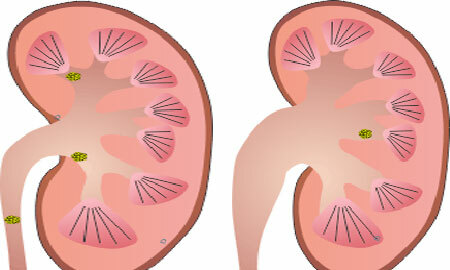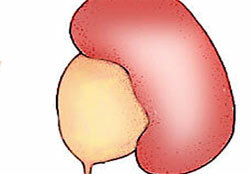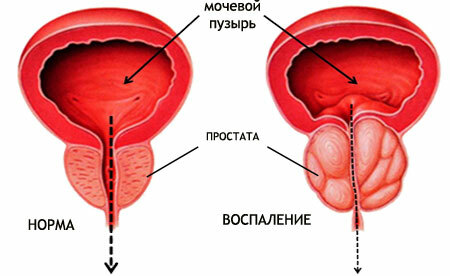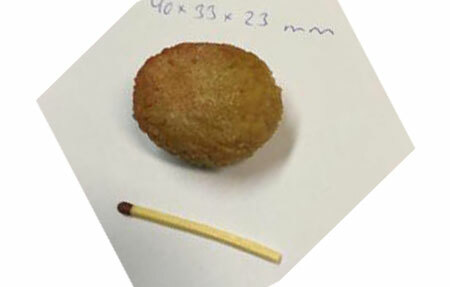Many patients are faced with a diagnosis of hydronephrosis of the kidney, but, what is it? To assess the severity of the disease, let's look at the nature and causes of the occurrence, as well as in what physiological processes are violated as a result of the development of pathology.
What is it? Hydronephrosis of the kidneys is a pathological process that represents an excessive enlargement of the renal pelvis - is formed as a result of a violation of the outflow of urine and the reason for this, often, is urolithiasis or neoplasms that close the ureteral lumen.
Scientists have established that no less than 2,000 liters of fluid passes through the kidneys per day, which is converted to 1.5-2.5 liters of urine. With her, slags and toxins, salts and metabolic products are eliminated from the body.

Clinical observations and statistical data indicate that patients rarely consult a specialist at the onset of the disease. Studies have shown that women are 1.5 times more likely to suffer from this disease than males. The disease affects people in the age category from 18 to 45 years.
Content
- 1 Causes of kidney hydronephrosis
- 2 Symptoms of hydronephrosis kidney
- 3 kidney hydronephrosis in pregnant
- 4 degrees of hydronephrosis kidney
- 5 Diagnosing kidney hydronephrosis
- 6 Treatment of kidney hydronephrosis
- 6.1 Surgical treatment of hydronephrosis kidney
- 7 Complications and prognosis of the disease
Causes of kidney hydronephrosis
better understand, that such hydronephrosis of kidneys, the reasons of occurrence of a pathology will help. Among the most common factors directly influencing the development of the disease are:
- Urolithiasis, leading to clogging of the duct and provoking the development of hydronephrosis.
- Neoplasms compressing the ureter and preventing a normal outflow of urine.
- Anomalies in the development of the urinary tract, characterized by a narrowing of the ureteral lumen.
- The presence of an additional renal artery.
- Consequences of concomitant diseases, which resulted in the narrowing of the duct. Relapses due to surgical intervention.
Doctors note - there may be several reasons for the development of the pathological process. And they have a complex effect on the body, which, combined with an incorrect lifestyle and lack of timely examination, leads to the development of kidney hydronephrosis.
Symptoms of kidney hydronephrosis

Diagnosis of the disease at an early stage of the pathological process is very difficult. The lack of clear clinical symptoms of kidney hydronephrosis is characteristic of the initial stage of the disease. And also, in the number of symptoms often fall those that are specific to the cause of the disease. So, with urolithiasis, the patient has an attack of renal colic, which disguises the traumatic pain in the lumbar region.
Among the most characteristic symptoms for hydronephrosis are:
- Stupid aching pain in the lumbar region, which does not vary depending on the position and activity of the patient. With hydronephrosis of the left kidney, as well as the right kidney, the localization zone will change according to the location of the affected organ.
- Enlargement of the kidney, determined by the physician on palpation.
- In hydronephrosis of the right kidney, the symptoms are similar to cholecystitis and manifest as a slight bloating accompanied by vomiting, diarrhea and pain. It is located on the right side of the abdomen.
- There is a growing pain syndrome in the afternoon, but at night the pain can subside.
- Muddy urine with an admixture of blood also should alert the patient and become an occasion for an immediate reference to a specialist.
The classic symptoms of kidney hydronephrosis are a combination of pain syndrome, hematuria( the presence of blood in the urine), as well as an increase in the affected organ.
Hydronephrosis of kidneys in pregnant women
Hydronephrosis of the kidneys in pregnant women can arise as an independent disease, which is caused by an increasing uterus in size. It squeezes the ureters, preventing the natural withdrawal of urine. Or it can be a chronic disease, aggravated as a result of increased stress on all organs at the time of pregnancy.
If hydronephrosis is a chronic disease, the specialist decides to terminate the pregnancy or establishes a permanent control over the state of health of the expectant mother.
This increased attention is associated with prolonged thinning of the wall and risk of rupture of the renal pelvis.
Degrees of hydronephrosis of the kidneys
 Long-term studies have made it possible to establish several degrees of kidney hydronephrosis. Urologists distinguish three stages of the course of the pathological process:
Long-term studies have made it possible to establish several degrees of kidney hydronephrosis. Urologists distinguish three stages of the course of the pathological process:
Early or first stage. At this stage, the enlargement of the renal pelvis is observed, which does not cause specific complaints and is characterized by increased fatigue and decreased patient activity.
It should also be noted - the clinical picture of the disease at the first stage is often not clear. The body tries to compensate for excess pressure and there is an increase in the muscular layer, as well as the amount of elastic fibers around the pelvis.
The second stage of the disease is , characterized by a violation of the outflow of urine. Also at this moment there is a gradual thinning of the wall of the renal pelvis. The organ function slowly decreases by 15-20%.
The third stage is .There is an excessive expansion of the walls of the pelvis and gradually the entire kidney turns into one large multi-chamber organ filled with urine. Urologists note that at this stage of the development of the pathological process, the kidney function is reduced by 75-80%.
At the final stage of the development of the disease, the organ often falls and practically ceases to function.
Most patients turn to specialists during the development of 2 or 3 degrees of kidney hydronephrosis. The lack of practice of routine checkups is the reason for not identifying the disease at an early stage.
Diagnosis of kidney hydronephrosis
For the diagnosis of kidney hydronephrosis, specialists use both laboratory and hardware methods to detect a pathological process. Among the most common and effective are:
- Inspection and palpation. At this stage, the urologist determines the increase in the affected organ, soreness and size. Differential diagnostics is necessary with such pathological processes as gastric ptosis or neoplasm of retroperitoneal space.
Among the laboratory methods of diagnosis include carrying out the analysis of urine and blood. This is a test for Zimnitskiy, Nichiporenko and others, no less effective studies. They allow you to identify the presence of blood, as well as determine the extent of kidney damage.
Hardware methods. They provide an opportunity to get full information about the affected organ and the condition of all tissues.
The most common hardware research methods include:
- ultrasound allows you to determine the presence of extensions in the renal-pelvic system and determine the size. The doctor at the time of the study has the opportunity to establish the thickness of the parenchyma layer, which is important for predicting the course of the disease.
- Radiographic study. Allows you to set clear sizes and boundaries of the renal pelvis. And intravenous contrast urography gives a unique chance to reveal the rate of formation and drainage of urine.
Using the methods of radioisotope urography, it is possible to determine the state of each kidney separately.
Such diagnostic methods as MRI and CT specialists are used to clarify the diagnosis for unclear clinical symptoms.
Treatment of hydronephrosis of the kidneys

In the early stages of the disease, when the lesions of the parenchyma and the walls of the pelvis are still reversible, it is possible to use medications that help restore the normal function of the organ. Treatment of kidney hydronephrosis is carried out in a hospital environment under the constant supervision of a specialist.
The essence of the therapy is reduced to eliminating the causes, so in most cases, urologists prescribe:
- Antibiotics - used to combat attached bacterial infections. It is it that can significantly complicate the patient's condition and often leads to the development of complications.
- Leaching therapy is used in diagnosed urolithiasis. The essence of the treatment is to dissolve the previously formed stones and remove them from the body.
- Hormone therapy is indicated if there is revealed retroperitoneal fibrosis.
Also widely used are anti-inflammatory, analgesic drugs, as well as means that regulate blood pressure.
In the later stages of the disease, specialists recommend surgical treatment.
Surgical methods for treating hydronephrosis of the kidneys
Surgeons use several key techniques to treat hydronephrosis transformations of the kidney.
In the early stages of the disease, ureteral lumen enlargement is effective, and later - plastic pelvis and size correction are shown. If the right kidney has undergone the hydronephrosis transformation, then the risk of damage to the pancreas is great in surgical treatment.
A few days before surgery, a catheter or cystostomy is installed to facilitate the drainage of urine and reduce the burden on the affected organ. With partial preservation of kidney function, the specialists perform one of the following operations:
- Creation of an additional estuary between the kidney and the ureter. Patchwork surgery.
- Endotomy of the sticure used to reduce the size of the pelvis.
- Kidney plasty using the laparoscopic technique.
- Ureteral boring.
Important is the diet, which is to reduce the amount of protein and increased fiber intake. This allows to reduce the load on the affected organ and to alleviate the patient's condition.
The recovery period takes about 14 days.
In the last stages of the course of the pathological process, the kidney is removed. This decision is made based on the results of the diagnostic examination, if the organ function is lost.
Complications and prognosis of
clinical trials Clinical studies have shown that with timely diagnosis and properly selected treatment, it is possible to restore partially lost kidney function. The prognosis is favorable, and the complications are directly related to the non-observance of the urologist's recommendations or the presence of concomitant diseases.
The most frequently occurring complications are:
- Pyelonephritis. There is both acute and chronic form.
- With late application for honey. The threat of a kidney rupture increases with the help and strong thinning of the wall of the pelvis.
- Chronic renal failure.
- Increased blood pressure, which can not be corrected by modern drugs and has serious consequences for the body.
In consultation with a urologist, one can apply hydronephrosis treatment with folk remedies. The maximum therapeutic effect can be achieved with a competent combination of folk remedies and medications.
But in this case you will need constant monitoring of the patient's condition. Among the most effective methods include:
- Pumpkin-based remedies.
- Infusions of parsley root.
- Infusion from the bean leaves.
Timely diagnosis, routine medical examination and strict adherence to the recommendations of a specialist allows to identify hydronephrosis at an early stage of the disease development. The forecast in this case will be favorable and the treatment will not take long.



